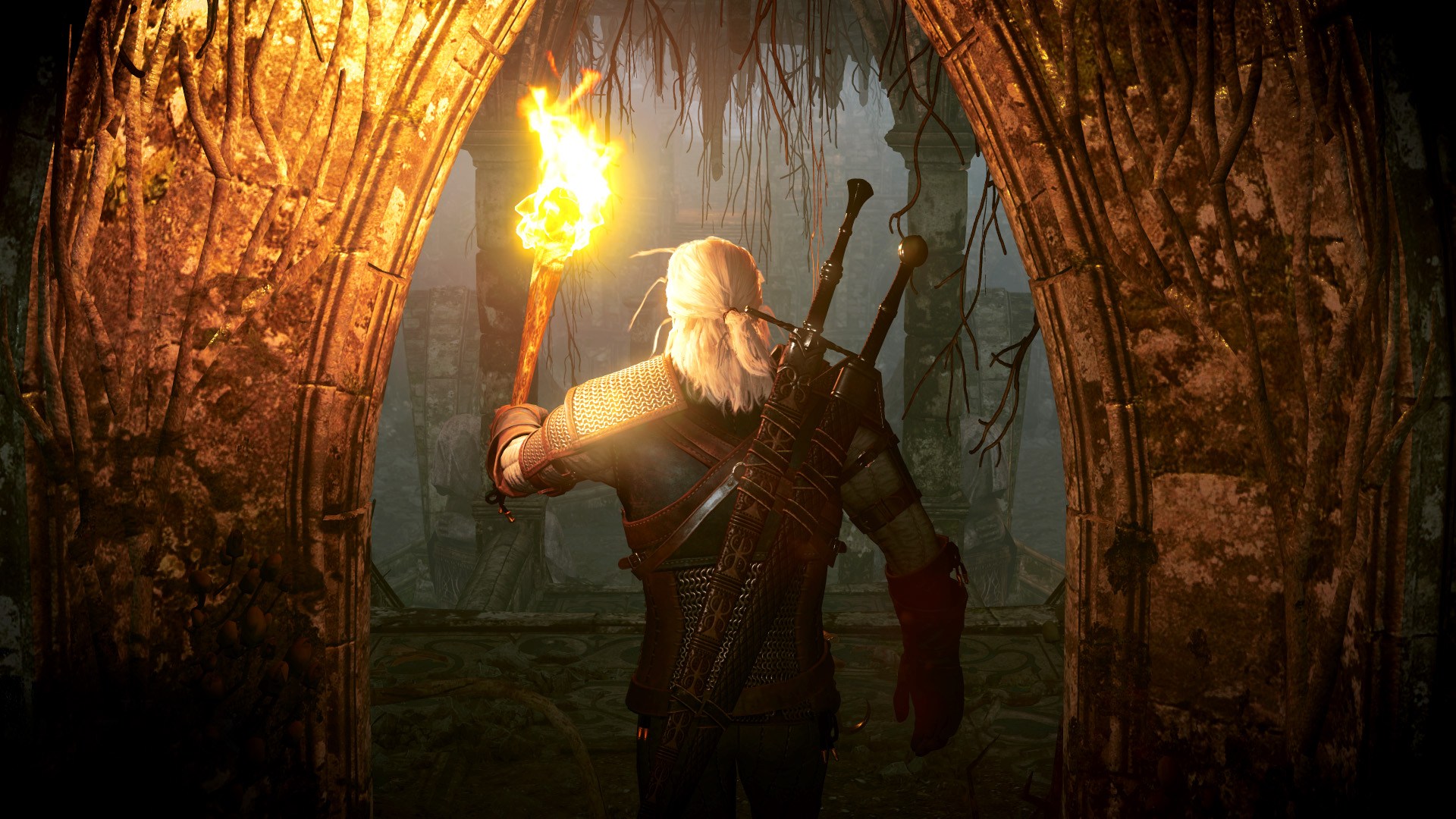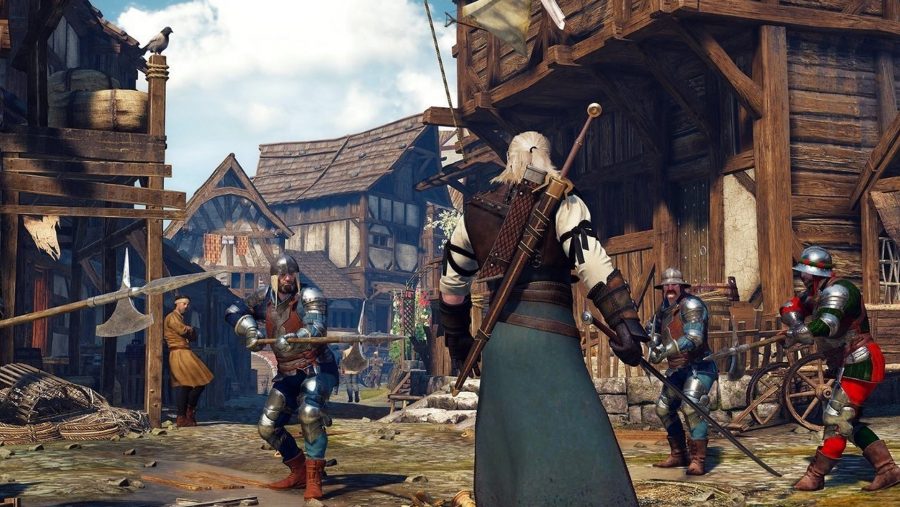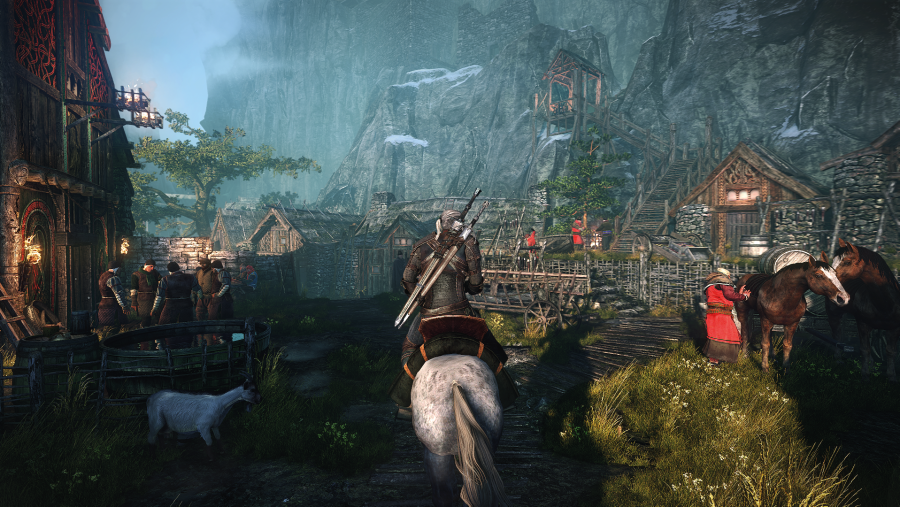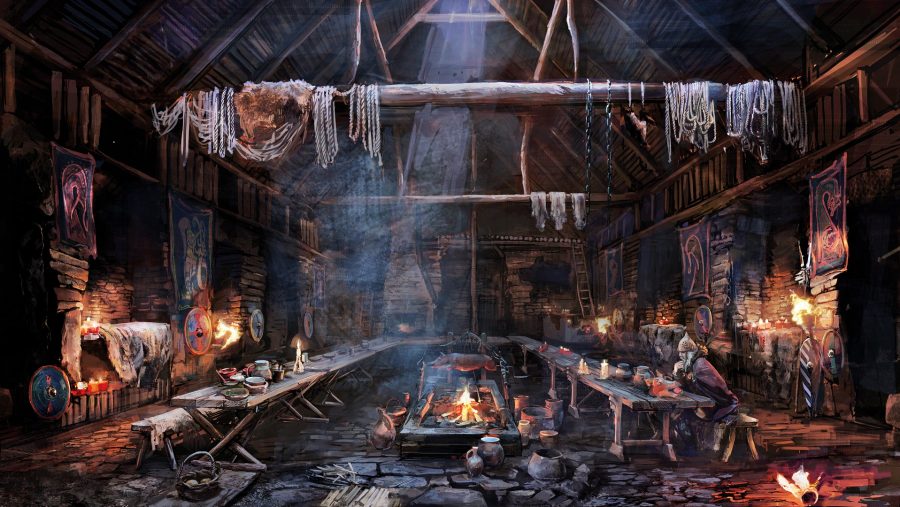My completionist attitude was satisified after I disabled "?" map markers and only did stuff I encountered in the game by actual travel/exploring. I probably missed a lot of treasures/monster nests/bandit camps/etc., but I completed every quest I did find and it was great fun.
-
Welcome to rpgcodex.net, a site dedicated to discussing computer based role-playing games in a free and open fashion. We're less strict than other forums, but please refer to the rules.
"This message is awaiting moderator approval": All new users must pass through our moderation queue before they will be able to post normally. Until your account has "passed" your posts will only be visible to yourself (and moderators) until they are approved. Give us a week to get around to approving / deleting / ignoring your mundane opinion on crap before hassling us about it. Once you have passed the moderation period (think of it as a test), you will be able to post normally, just like all the other retards.
You are using an out of date browser. It may not display this or other websites correctly.
You should upgrade or use an alternative browser.
You should upgrade or use an alternative browser.
The Witcher 3 GOTY Edition
- Thread starter Infinitron
- Start date
Yes, I also disabled the minimap and quest markers as well as the HUD and it makes the game so much more immersiveMy completionist attitude was satisified after I disabled "?" map markers and only did stuff I encountered in the game by actual travel/exploring. I probably missed a lot of treasures/monster nests/bandit camps/etc., but I completed every quest I did find and it was great fun.
Paul_cz
Arcane
- Joined
- Jan 26, 2014
- Messages
- 2,130
Yeah I still think one of the greatest design missteps was leaving PoI markers enabled by default, because it turned the map into dumb Ubisofthathon. Also, they should have included Fog of war on the map to let player know where he's already been and where not.
After you get a quest from notice board, you can follow it from the journal.but without those map markers, notice board doesnt give rumor directions no?
attackfighter
Magister
- Joined
- Jul 15, 2010
- Messages
- 2,307
The weird thing about the Witcher series is that, despite having some of the best writing around today, its writers purportedly think its all a bunch of trash, that they're just hacking out a bunch of puerile drivel with no artistry involved.
Sizzle
Arcane
- Joined
- Feb 17, 2012
- Messages
- 2,473
The weird thing about the Witcher series is that, despite having some of the best writing around today, its writers purportedly think its all a bunch of trash, that they're just hacking out a bunch of puerile drivel with no artistry involved.
Got any sources on this, it's the first time I've heard of it.
attackfighter
Magister
- Joined
- Jul 15, 2010
- Messages
- 2,307
The weird thing about the Witcher series is that, despite having some of the best writing around today, its writers purportedly think its all a bunch of trash, that they're just hacking out a bunch of puerile drivel with no artistry involved.
Got any sources on this, it's the first time I've heard of it.
It's located somewhere in here, I think. It's just one of the (three) writers who says it, but he basically denigrates his work by saying there's no self-expression involved, just application of technique.
While looking for it, I also found this, by a different Witcher writer:
“The games about Geralt contend that evil has its source in people – in their lies and weaknesses that others can easily exploit,” Blacha continued. “Stories of this kind are far more suggestive than, say, a story about an invasion by evil demons. True, we use supernatural beings and forces in the games, but merely as metaphors. The Beast from the Outskirts is not scary just because it’s a dangerous monster. It’s also frightening because it’s an incarnation of misdeeds and sins we might witness or experience in our daily lives.”
Could this be taking an intentional jab at Bioware, in referring to stories about "evil [invading] demons"? That seems to characterize most of the Mass Effect and Dragon Age series. The rest of the article is similarly worthwhile.
Paul_cz
Arcane
- Joined
- Jan 26, 2014
- Messages
- 2,130
I think it is a jab at this trope in general, from LOTR to Dragon Age to Oblivion to...almost every fantasy RPG ever made. And Witcher 3 could be accused of it too to a degree with Wild Hunt being too twodimensional, but at least they are just normal elves in fancy armors who want to invade to save their hides (and enslave while at it) instead of being your garden variety demons. And of course they were intended to be portrayed in more detail until some unfortunate cuts had to be made (I remember CDP talking about a cut quest where Geralt infiltrated Wild Hund and could talk with them in detail).The weird thing about the Witcher series is that, despite having some of the best writing around today, its writers purportedly think its all a bunch of trash, that they're just hacking out a bunch of puerile drivel with no artistry involved.
Got any sources on this, it's the first time I've heard of it.
It's located somewhere in here, I think. It's just one of the (three) writers who says it, but he basically denigrates his work by saying there's no self-expression involved, just application of technique.
While looking for it, I also found this, by a different Witcher writer:
“The games about Geralt contend that evil has its source in people – in their lies and weaknesses that others can easily exploit,” Blacha continued. “Stories of this kind are far more suggestive than, say, a story about an invasion by evil demons. True, we use supernatural beings and forces in the games, but merely as metaphors. The Beast from the Outskirts is not scary just because it’s a dangerous monster. It’s also frightening because it’s an incarnation of misdeeds and sins we might witness or experience in our daily lives.”
Could this be taking an intentional jab at Bioware, in referring to stories about "evil [invading] demons"? That seems to characterize most of the Mass Effect and Dragon Age series. The rest of the article is similarly worthwhile.
attackfighter
Magister
- Joined
- Jul 15, 2010
- Messages
- 2,307
I think it is a jab at this trope in general, from LOTR to Dragon Age to Oblivion to...almost every fantasy RPG ever made. And Witcher 3 could be accused of it too to a degree with Wild Hunt being too twodimensional, but at least they are just normal elves in fancy armors who want to invade to save their hides (and enslave while at it) instead of being your garden variety demons. And of course they were intended to be portrayed in more detail until some unfortunate cuts had to be made (I remember CDP talking about a cut quest where Geralt infiltrated Wild Hund and could talk with them in detail).The weird thing about the Witcher series is that, despite having some of the best writing around today, its writers purportedly think its all a bunch of trash, that they're just hacking out a bunch of puerile drivel with no artistry involved.
Got any sources on this, it's the first time I've heard of it.
It's located somewhere in here, I think. It's just one of the (three) writers who says it, but he basically denigrates his work by saying there's no self-expression involved, just application of technique.
While looking for it, I also found this, by a different Witcher writer:
“The games about Geralt contend that evil has its source in people – in their lies and weaknesses that others can easily exploit,” Blacha continued. “Stories of this kind are far more suggestive than, say, a story about an invasion by evil demons. True, we use supernatural beings and forces in the games, but merely as metaphors. The Beast from the Outskirts is not scary just because it’s a dangerous monster. It’s also frightening because it’s an incarnation of misdeeds and sins we might witness or experience in our daily lives.”
Could this be taking an intentional jab at Bioware, in referring to stories about "evil [invading] demons"? That seems to characterize most of the Mass Effect and Dragon Age series. The rest of the article is similarly worthwhile.
Orcs are evil demons, true, and LOTR leans heavily on the good vs. evil trope, but, like Witcher, its elements have a lot of symbolic weight behind them, so that they are more meaningful than just, say, darkspawn or collectors/reapers, which truly are superficial. I actually forgot that Oblivion was about defeating daedra or something. For modern games, or at least modern, earnest RPGs, Bioware seems to be the most prominent example, seems to be the exemplar, even, of the 'evil demons invading the land' cliche, so that I think the writer is referencing them in regards to what he considers banal.
- Joined
- Jan 28, 2011
- Messages
- 99,696















https://www.pcgamesn.com/the-witcher-3-wild-hunt/the-witcher-3-wild-hunt-books-to-games
How CD Projekt Red brought the world of The Witcher from page to screen
Bringing the fantastical world of The Witcher books to PC screens took a lot more imagination than you might think

CD Projekt Red did a wonderful job of bringing Andrzej Sapkowski’s books to life with its The Witcher series of games. This was because the team took the descriptions from the novels and translated them from page to screen with aplomb.
Look to the game’s version of the lonely Witcher keep of Kaer Morhen, which Sapkowski writes as being ‘huddled against the stone precipices’ in the mountains of Kaedwen, and you’ll see a rocky keep crouched under high walls. Or there’s the bustling streets of Novigrad, which Sapkowski presents as ‘the cradle of culture,’ which you can see reflected in the banks, brothels, and bathhouses you run between in The Witcher 3: Wild Hunt.
But there’s a lot more to visualising this architecture as the original author wrote it – game development demands embellishment. “It’s not as straightforward as taking a description from the books and recreating its content in the game,” Peter Gelencser, level design coordinator at CD Projekt Red, tells me. “Adjustments are often required […] to make a location stand out or have it fulfil a particular purpose during exploration.”
First, the descriptions in Sapkowski’s books churn through quest designers and environment artists. They love the lore, but have the flow of the game and player experience in their best interest, so locations will go through changes to match the story, activities, and the feel according to Gelencser.
The source material is instructive, then, but it’s more of a valuable starting point than a blueprint. For instance, with The Witcher 3’s Novigrad, the team knew it wanted the environment to feel huge, to match the descriptions from the books. In the short story The Eternal Flame, Dandelion emphasizes just how large Novigrad is, and this was an essential aspect for CD Projekt Red to convey in the game:
‘Novigrad, I tell you, is the capital of the world. Almost thirty thousand dwellers, Geralt, not counting the travellers; just imagine! Brick houses, cobbled main streets, a seaport, stores, shops, four watermills, slaughterhouses, sawmills, a large manufactory making beautiful slippers, and every conceivable guild and trade.’ (Sword of Destiny, Eternal Flame, page 134)
If you take a walk around Novigrad it’s easy to see the team’s success. Novigrad, in stark contrast to the war-torn and starving Velen, is a sprawling city. It’s a melting pot of different cultures, classes, and trades, with opulent buildings sat alongside mud-splattered quarters for the poorer residents. With plenty to discover around every corner it’s easy to get lost in its streets.
During the making of The Witcher 3, though, the team started taking more liberties with Kaer Morhen and added new details to sell the player on the passage of time. These changes took advantage of the improved technology. As a result, Kaer Morhen in The Witcher 3 feels more overgrown and dilapidated, with an abundance of weeds and a huge wooden scaffolding holding the keep together.
“A lot of time has passed between the two installments and it would’ve been a great shame and waste if we didn’t show this in the game,” Gelencser says. “This freedom was a fantastic driving force to explore that which we simply weren’t able to before. It was a lot of fun, as well as a chance to look back on where we came from, which kept motivating us to push the scope and quality further and further. There’s also the case that members of our studio’s environment art and level design teams are really into ruins and take great pleasure in putting as many vines, cracks, moss, and deteriorating scaffolds as they can get away with.”
In The Witcher 3, the team also had the opportunity for the first time to explore the surroundings of the keep, letting players see even more locations from the books. This includes ‘the gullies and gorges’ that Triss explores on her way to Kaer Morhen at the beginning of Blood of Elves.
“The two main considerations were lore and opportunity,” Gelencser explains, talking about the area’s design. “The former acted primarily as quest design fuel, whereas level design went on a hike, metaphorically speaking, and explored the land beyond Kaer Morhen’s walls as sculptors of a forgotten valley.
“We drew a lot of inspiration from the natural shapes of the area surrounding the keep and iterated on them with passion and curiosity. It was like putting a puzzle together – the lands, points of interests, paths, caves all serving as pieces of that puzzle.”
Arguably the biggest challenge during the development of The Witcher 3 was the region of Skellige. Not much is written about Skellige until the fourth book in the saga, The Tower of the Swallow, with most of the interactions with the islanders coming from chance encounters on the main continent. Nevertheless, in the book, Sapkowski does provide some insight into what Skellige is like, such as when Yennefer looks out from Kaer Trolde:
‘Almost the entire archipelago was visible from the upper terraces of the citadel of Kaer Trolde, the main fortress of Ard Skellig. Straight ahead, across the sound, was An Skellig – low and flat on the south side and covered by steep fjords on the north. To the left, far away, the sharp tusks and high cliffs of green Spikeroog rose above the waves; the peaks disappearing in the clouds. To the right one could see the steep cliffs of the island Undvik, on which swarmed gulls, petrels, cormorants, and gannets.’
Skellige’s topography is accurately represented in The Witcher 3, with players able to climb to the top of Kaer Trolde and see pretty much of all what is described in the book. However, the development team also looked at tons of reference material from real places, like the Faroe Islands, Medieval Iceland, and Greenland, to flesh out the region and create an open world that felt distinct from the main continent.
“We also looked into cultural models of isolated societies – how they react to outside influences, what’s their attitude towards newcomers,” Jakub Szamałek, principal writer at CD Projekt Red, tells me. “We then made sure that all the settlements and villages make sense within their context, and so the walls are made from local rocks rather than bricks, as clay would have been scarce on these rocky isles. There are few fields, because Skellige’s soils wouldn’t have been able to support intensive agriculture – but shepherding and fishing plays a much bigger role than on the Continent.”
The Witcher games remain the most faithful adaptations of Andrzej Sapkowski’s work, bringing his world to life with an impressive knowledge of – and respect for – the original source material.
It is clear that this was no easy task, requiring CD Projekt Red to collaborate across multiple departments, including their concept artists, environment artists, and quest designers. And that’s not to mention the research they needed to put in to make sure the world felt populated and that every region had its own history and sense of place.
If you haven’t yet read The Witcher Saga – or the short story collections The Last Wish or The Sword of Destiny – I wholeheartedly recommend picking them up. They will broaden your appreciation of the task that CD Projekt Red faced with the Witcher games and should make you notice the level of depth and creativity poured into the game’s world.
unfairlight
Self-Ejected
- Joined
- Aug 20, 2017
- Messages
- 4,092
Am I actually missing out on anything by not playing this game or is there something interesting in it? It sounds like it's just a lot of AAA art assets put into a game that does nothing that Gothic/Elder Scrolls/Bioware games haven't done before.
Paul_cz
Arcane
- Joined
- Jan 26, 2014
- Messages
- 2,130
Why not read RPGCodex review?Am I actually missing out on anything by not playing this game or is there something interesting in it? It sounds like it's just a lot of AAA art assets put into a game that does nothing that Gothic/Elder Scrolls/Bioware games haven't done before.
Frozen
Arcane
- Joined
- Jan 1, 2014
- Messages
- 8,743
Am I actually missing out on anything by not playing this game or is there something interesting in it? It sounds like it's just a lot of AAA art assets put into a game that does nothing that Gothic/Elder Scrolls/Bioware games haven't done before.
If you are a storyfag you will enjoy story aspect (not that story is great but its done with high production values) and the world looks nice even if its empty.
Gameplay soon becomes boring and repetitive and don't expect exploration because inventory system is broken (99% of items are useless junk to sell)
- Joined
- Sep 14, 2016
- Messages
- 6,563

Atmosphere and questing, I guess. Quests are mostly well done and fairly unique. And NPCs with their dialogues as well.
Though using the radar to solve a lot of them gets old.
Atmosphere is very rich, particularly in the first part of the game.
Though using the radar to solve a lot of them gets old.
Atmosphere is very rich, particularly in the first part of the game.
unfairlight
Self-Ejected
- Joined
- Aug 20, 2017
- Messages
- 4,092
I guess I'll pirate it when I get my new PC because I don't even know if I would like it or not. Thanks guys.
- Joined
- Jan 29, 2017
- Messages
- 900
Use the enhanced edition mod. Delevels the world so a drowner is a drowner no matter where you find and does a whole lot more to.I guess I'll pirate it when I get my new PC because I don't even know if I would like it or not. Thanks guys.
Its certainly worth playing as an example of AAA open world done right, but it still has the same flaw of being far to large and bloated for its own good. So maybe ignore all the side stuff if you want a chance of finishing the game? I have tried to play it through a couple of times and I always hit the mid point and get bored and give up.
Witcher 3's greatest asset is that it's a feast for the eyes. Here I'm not referring to polygon count or texture resolution, but the art direction which is perhaps the most on-point of any video game I've played. It goes a long way in making the world feel genuine. IMO it's worth playing purely to SEE all of the things that it has to offer.
I'd still go with this lighting mod, like the colder colors https://www.nexusmods.com/witcher3/mods/657/
All the red in mornings and sunsets was bothering me.
All the red in mornings and sunsets was bothering me.







![Glory to Codexia! [2012] Codex 2012](/forums/smiles/campaign_tags/campaign_slushfund2012.png)
![Have Many Potato [2013] Codex 2013](/forums/smiles/campaign_tags/campaign_potato2013.png)
![The Year of Incline [2014] Codex 2014](/forums/smiles/campaign_tags/campaign_incline2014.png)

















